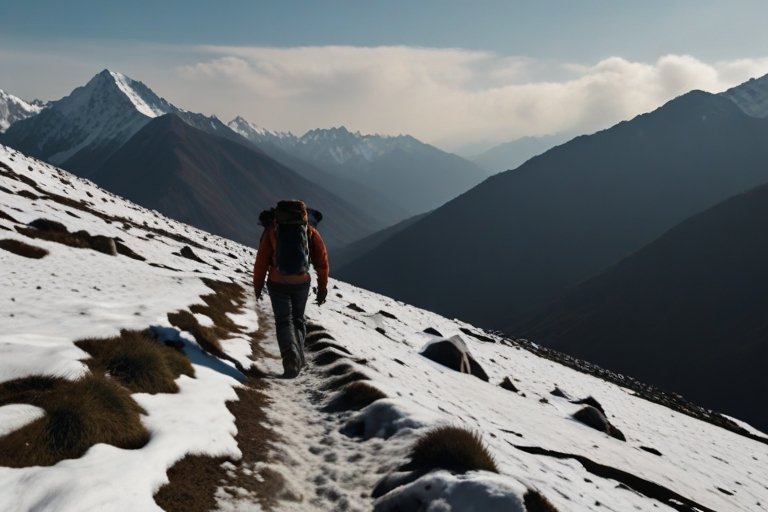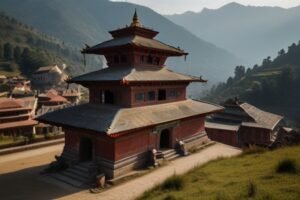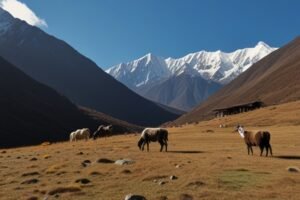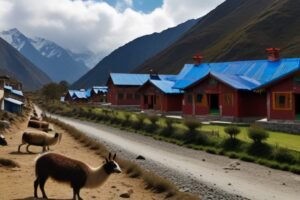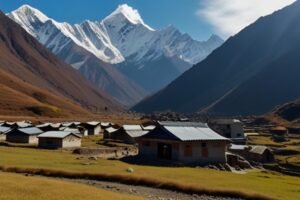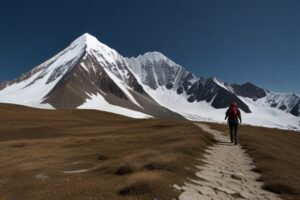“Embark on an Epic Journey: Langtang Valley Trek”
Nestled in the heart of Nepal, the Langtang Valley beckons adventurers with its pristine beauty, snow-capped peaks, and vibrant culture. Imagine walking through lush forests, crossing suspension bridges over roaring rivers, and gazing at the majestic Langtang Lirung (7,227 meters) – all in just six days. This trek is a symphony of nature, culture, and awe-inspiring landscapes.
In this comprehensive guide, we unravel the Langtang Valley Trek, revealing its hidden gems, practical tips, and unforgettable experiences. Whether you’re a seasoned trekker or a first-timer, get ready for an unforgettable journey through the Langtang region.
Key Takeaways Of Langtang Valley Trek
- Scenic Beauty: The trek offers breathtaking views of snow-capped peaks, lush forests, and picturesque valleys.
- Cultural Exploration: Encounter local Tamang and Tibetan communities, visit ancient monasteries, and immerse yourself in their rich culture.
- Langtang National Park: The trek takes you through Langtang National Park, home to diverse flora and fauna, including the elusive red panda.
- Kyanjin Gompa: Reach Kyanjin Gompa, a serene village surrounded by towering mountains. Don’t miss the opportunity to hike up to Tserko Ri for panoramic vistas.
- Moderate Difficulty: The Langtang Valley Trek is suitable for trekkers with moderate fitness levels. Altitude gains are gradual.
Remember to pack warm clothing, sturdy trekking shoes, and a sense of adventure! 🏔️🚶♂️🌄
Trek Itinerary
Day 1: Kathmandu to Syabrubesi
The Kathmandu to Syabrubesi route is a gateway to the enchanting Langtang Valley. This rugged overland adventure takes you from Nepal’s bustling capital to the serene mountain settlement of Syabrubesi, nestled at an elevation of 2,380 meters. Whether you’re a trekking enthusiast or a nature lover, this journey promises breathtaking vistas, cultural encounters, and a taste of Himalayan life.
Distance and Duration
The distance between Kathmandu and Syabrubesi is approximately 80 kilometers1. While the crow flies, it’s not too far, but the winding mountain roads make the journey more adventurous. Here are your transport options:
- Bus: The most economical choice is taking a bus from Kathmandu Machhapokhari to Syaphrubesi. The bus ride takes around 2 hours and 11 minutes and costs approximately $92. You’ll traverse scenic landscapes, cross bridges, and witness the gradual transition from city chaos to tranquil mountain beauty.
- Taxi: If you prefer a more comfortable ride, consider hiring a taxi. The taxi journey covers the same distance and takes approximately 2 hours and 53 minutes. Expect to pay around $100 – $1202. The advantage? You’ll have more legroom and can enjoy the views without worrying about crowded seats.
- Drive: For those who love the open road, driving from Kathmandu to Syabrubesi is an option. The drive takes roughly the same time as the taxi – about 2 hours and 53 minutes. Fuel up, pack some snacks, and embark on this scenic adventure. The cost for driving is approximately $15 – $222.
Why Syabrubesi?
Syabrubesi isn’t just a pit stop; it’s the gateway to the Langtang National Park. Here’s why it’s worth the journey:
- Langtang Lirung Views: As you approach Syabrubesi, catch glimpses of the majestic Langtang Lirung (7,227 meters). The anticipation builds, promising even more stunning vistas ahead.
- Tamang Culture: Syabrubesi is home to the warm and welcoming Tamang community. Immerse yourself in their traditions, taste local cuisine, and learn about their way of life.
- Starting Point for Treks: From Syabrubesi, trekkers set off on adventures to Langtang Valley, Gosaikunda, and beyond. The Langtang Valley Trek is a rewarding experience, offering rhododendron forests, snow-capped peaks, and encounters with yaks and Himalayan wildlife.
So, whether you choose the bus, taxi, or the thrill of driving, let the Kathmandu-Syabrubesi route be your gateway to Himalayan bliss! 🏔️✨
Day 2: Pairo to Lama Hotel
The stretch from Pairo to Lama Hotel is a delightful segment of the Langtang Valley Trek. As you leave Pairo behind, the trail meanders through lush forests, alongside the Langtang Khola, and gradually ascends to Lama Hotel. Let’s dive into the details:
Trail Overview
- Distance: Approximately 15.7 kilometers (9.7 miles)
- Duration: Around 5 hours
- Ascent: 1,247 meters
- Descent: 278 meters
The Journey
- Pairo to Bamboo: From Pairo, embark on a 25-30 minute gentle walk up the narrowing valley. The trail leads you to Bamboo, where the Langtang Khola flows alongside. The soothing sound of the river accompanies you as you tread through rhododendron and oak forests.
- Bamboo to Rimche: Continue your ascent, crossing suspension bridges and passing through charming villages. Rimche awaits you, offering a glimpse of the rugged beauty that lies ahead.
- Rimche to Lama Hotel: Lama Hotel, at an elevation of 2,447 meters, greets you with its traditional stone teahouses. Here, you’ll find simplicity and authenticity. There’s no phone signal, WiFi, or mains electricity – just the serenity of the mountains and limited solar power. Lama Hotel is a place to rest, recharge, and connect with fellow trekkers.
Accommodation and Amenities
- Lama Hotel boasts around eight teahouses, mostly built from local stone.
- Expect basic facilities: cozy rooms, warm blankets, and hearty meals.
- The absence of modern amenities adds to the rustic charm – a chance to disconnect and immerse yourself in nature.
Tips for Lama Hotel Stay
- Pack Light: Since amenities are minimal, pack only essentials.
- Enjoy the Silence: Lama Hotel’s lack of connectivity allows you to truly appreciate the tranquility.
- Solar Power: Charging devices may be limited, so conserve battery.
So, rest your weary legs, sip some hot tea, and let Lama Hotel’s simplicity weave its spell on you. 🏔️✨
Day 3: Lama Hotel to Langtang Village
The journey from Lama Hotel to Langtang Village is a captivating segment of the Langtang Valley Trek. As you traverse this scenic trail, you’ll encounter lush forests, charming villages, and the warm hospitality of the local Tamang community. Let’s delve into the details:
Trail Overview
- Distance: Approximately 14 kilometers (8.6 miles)
- Duration: Around 4 hours
- Ascent: 1,075 meters
- Descent: 155 meters
The Trek
- Lama Hotel to Ghodatabela: Begin your day by walking along the Langtang Khola, crossing suspension bridges, and ascending gradually. Pass through villages like Thyangsyapu and Chyamki. The trail offers glimpses of the majestic Langtang Lirung and the Ganesh Himal.
- Ghodatabela to Langtang Village: As you approach Langtang Village, the landscape changes. The village, perched at an elevation of 3,500 meters, welcomes you with its traditional stone houses and vibrant culture. Explore the local monasteries, interact with the friendly locals, and savor the simplicity of mountain life.
Accommodation and Amenities
- Langtang Village provides several teahouses/guesthouses for trekkers.
- Expect basic facilities: cozy rooms, warm blankets, and hearty meals.
- The village’s serene ambiance allows you to unwind and connect with fellow travelers.
Cultural Insights
- Tamang Heritage: Langtang Village is predominantly inhabited by the Tamang ethnic group. Immerse yourself in their rich culture, taste local cuisine, and witness their traditional dances.
- Buddhist Influence: Explore the local monasteries adorned with prayer flags and spinning wheels. The spiritual energy is palpable.
So, as you tread the path from Lama Hotel to Langtang Village, let the mountains whisper their tales and the prayer flags flutter in harmony. 🏔️🙏
Day 4: Langtang Village to Kyanjin Gompa
The trail from Langtang Village to Kyanjin Gompa is a mesmerizing journey through the heart of the Langtang Valley. As you ascend, you’ll witness snow-capped peaks, ancient monasteries, and the warm hospitality of the local Tamang community. Let’s explore this enchanting segment:
Trail Overview
- Distance: Approximately 14.5 kilometers (9 miles)
- Duration: Around 7-8 hours
- Ascent: 400 meters
- Descent: 1,400 meters
The Trek
- Langtang Village to Mundu: Begin your day by leaving Langtang Village behind. The trail winds through rhododendron forests, offering glimpses of the Langtang Lirung and other peaks. Pass by the village of Mundu, where prayer flags flutter in the mountain breeze.
- Mundu to Kyanjin Gompa: As you continue, the landscape changes dramatically. The path opens up to reveal the Kyanjin Gompa monastery against a backdrop of towering mountains. At an elevation of 3,870 meters, Kyanjin Gompa is a spiritual haven. Explore the ancient monastery, spin the prayer wheels, and soak in the serene atmosphere.
Accommodation and Amenities
- Kyanjin Gompa offers several teahouses for weary trekkers.
- Expect basic facilities: cozy rooms, warm blankets, and nourishing meals.
- The teahouses are perched amidst breathtaking scenery, allowing you to savor every moment.
Cultural Insights
- Kyanjin Gompa Monastery: Visit the centuries-old monastery, where monks chant prayers and meditate. The intricate murals and ancient artifacts tell stories of devotion and enlightenment.
- Yak Cheese Factory: Don’t miss the opportunity to taste fresh yak cheese produced locally. The cheese factory at Kyanjin Gompa is a unique experience.
So, as you ascend toward Kyanjin Gompa, let the mountains whisper their ancient secrets, and may your journey be filled with wonder. 🏔️🙏
Day 5: Kyanjin Ri or Tserkuri Peak Hike
In the heart of the Langtang Valley, two majestic peaks beckon trekkers seeking adventure and breathtaking views: Kyanjin Ri and Tserko Ri. Let’s explore these Himalayan giants:
1. Kyanjin Ri
- Altitude: 4,700 meters
- Difficulty: Moderate
- Duration: Approximately 3-4 hours round trip
- Highlights:
- Vertical Gain: With over 750 meters of ascent in just a few kilometers, Kyanjin Ri offers a steep climb.
- Views: From the viewpoint, feast your eyes on the snow-capped peaks, including the mighty Langtang Lirung.
- Challenges: The altitude and steep grade make it quite challenging, but most trekkers can manage their way up the ridge.
- Safety: The track is wide, and there are few drop-offs, so real dangers are minimal.
2. Tserko Ri
- Altitude: 5,000 meters
- Difficulty: Strenuous
- Duration: Longer than Kyanjin Ri (plan for a full day)
- Highlights:
- Vertical Gain: Tserko Ri boasts almost 1,500 meters of vertical gain to the summit.
- Panoramic Views: The high point of the Langtang Valley Trek, Tserko Ri rewards you with sweeping vistas of the entire valley.
- AMS Risk: Be cautious; the altitude can lead to Acute Mountain Sickness (AMS). Proper acclimatization is crucial.
- Reward: The effort is worth it – the highlight of your Langtang adventure!
Tips for Both Peaks
- Gear: Wear sturdy hiking boots, carry layers for changing weather, and use trekking poles.
- Hydration: Stay hydrated at high altitudes.
- Guided Treks: Consider trekking with a local guide for safety and cultural insights.
So, whether you choose Kyanjin Ri’s shorter ascent or Tserko Ri’s lofty challenge, let the Langtang peaks etch themselves into your soul. 🏔️✨
Day 6: Return to Syabrubesi and Drive to Kathmandu
As your Langtang Valley adventure draws to a close, it’s time to bid farewell to the serene mountains and head back to civilization. Here’s how you can return from Syabrubesi to Kathmandu:
1. Syabrubesi to Kathmandu by Overland Routes
Shared Jeep or Bus (Recommended)
- Duration: Approximately 5+ hours
- Route: Shared jeeps ply the winding mountain roads between Syabrubesi and Kathmandu. These moderately safe and comfortable vehicles are often shared with locals or fellow trekkers. They typically make a food and comfort stop at Trisuli Bazaar. Some shared jeeps terminate at Dhunche, a few miles before Syabrubesi.
- Private Jeep (More Comfortable): For a more comfortable journey, consider hiring a private jeep exclusively for you and your party. These private jeeps follow the same road as shared jeeps but allow you to stop wherever you like along the way. You can arrange a private jeep independently or through your trekking company.
Road Conditions and Safety
- The road from Syabrubesi to Kathmandu has some good sections but also challenging spots.
- The distance is approximately 80 kilometers, but the winding mountain roads make the journey longer.
- Be cautious during the ride, especially when the road gets close to Dhunche, as some sections are susceptible to landslides.
So, as you drive back to Kathmandu, let the mountains whisper their final tales, and may your return be as rewarding as your trek. 🏔️✨
Frequently Asked Questions (FAQs) about Langtang Valley Trek
Here are answers to common questions trekkers might have about the Langtang Valley Trek with a 6-day itinerary:
| Question | Answer |
|---|---|
| 1. Is the 6-day Langtang Valley Trek suitable for beginners? | Yes, the 6-day itinerary is manageable for beginners. However, some sections involve steep ascents and descents. |
| 2. What is the maximum altitude reached during this trek? | The highest point is Kyanjin Ri at 4,700 meters. |
| 3. Can I hike Tserko Ri in 6 days? | While possible, it’s challenging. Consider extending your trek for a more comfortable experience. |
| 4. How long is the total distance covered? | The trek covers approximately 77 km (including Kyanjin Ri). |
| 5. What permits are required? | You’ll need a Langtang Conservation Area Permit (NPR 3000 for foreigners) purchased at the entry point. |
| 6. What’s the road journey like from Kathmandu to Syabrubesi? | It’s an 8-hour drive through scenic mountain roads. |
| 7. Where can I stay in Syabrubesi? | Consider Hotel Pairo for better rates. |
| 8. What’s the trail like from Pairo to Thangshayap or Langtang Village? | Expect a mix of ascents and descents through forests and villages. |
| 9. What’s the accommodation like along the trail? | Basic teahouses with cozy rooms and simple meals. |
| 10. Can I experience Tamang culture? | Yes, Langtang Village offers insights into the Tamang ethnic group. |
| 11. What’s the best time to trek? | Spring (March to May) and autumn (September to November) are ideal. |
| 12. Is altitude sickness a concern? | Yes, especially if you ascend too quickly. Acclimatize properly. |
| 13. Can I taste local yak cheese? | Yes, visit the yak cheese factory at Kyanjin Gompa. |
| 14. How physically demanding is Kyanjin Ri? | It’s moderate, but the views are worth it. |
| 15. What gear should I bring? | Sturdy boots, layers, and trekking poles are essential. |
| 16. Can I trek independently or should I hire a guide? | Both options are possible, but a guide ensures safety and cultural insights. |
| 17. What’s the return journey like from Syabrubesi to Kathmandu? | Shared jeeps or private jeeps are recommended. |
| 18. How much does the trek cost? | Budget around $150 for transportation and $10 – $20 per night for accommodation. |
| 19. What’s the sentiment among trekkers? | A mix of awe, fulfillment, and gratitude. |
| 20. Any final tips? | Enjoy the mountains, disconnect, and let the Langtang peaks etch themselves into your soul. |
After exploring the frequently asked questions, you’ll be well-prepared for your Langtang Valley Trek. Remember to pack your sense of adventure and embrace the stunning Himalayan vistas! 🏔️🚶♂️🌄
Pre-Trip Checklist for Langtang Valley Trek: Essential Items to Pack
Before embarking on your Langtang Valley Trek, ensure you have the right gear and essentials. Here’s a comprehensive checklist to help you prepare:
Clothing (All Seasons)
- Base Layers:
- Moisture-wicking T-shirts (long-sleeve and short-sleeve)
- Thermal tops (for colder months)
- Insulating Layers:
- Fleece jacket or down jacket
- Insulated pants (optional)
- Outer Layers:
- Waterproof and windproof jacket
- Waterproof pants or trekking pants
- Headwear:
- Sun hat or cap
- Beanie or warm hat (for colder days)
- Sunglasses with UV protection
- Gloves:
- Lightweight gloves (for lower altitudes)
- Insulated gloves (for higher altitudes)
- Footwear:
- Sturdy hiking boots (broken in)
- Hiking socks (moisture-wicking)
- Miscellaneous Clothing:
- Underwear
- Sports bras (for women)
- Swimsuit (for hot springs)
Additional Miscellaneous Items
- Backpack:
- Daypack (for daily essentials during the trek)
- Sleeping Bag:
- Rated for cold temperatures (check the season)
- Water Bottle or Hydration System:
- Stay hydrated along the trail
- Headlamp or Flashlight:
- Essential for evening use
- Toiletries:
- Toilet paper
- Wet wipes
- Hand sanitizer
- First Aid Kit:
- Bandages, antiseptics, blister treatment, etc.
- Sunscreen and Lip Balm:
- Protect your skin from UV rays
- Camera or Smartphone:
- Capture the stunning landscapes
Hiking Items
- Trekking Poles:
- Reduce strain on knees during descents
- Maps and Compass:
- Familiarize yourself with the route
- Snacks and Energy Bars:
- Keep your energy levels up
- Cash and Small Denominations:
- For purchasing snacks, water, and souvenirs
Estimated Costs (for Reference)
- Permits: TIMS card and Park entrance permit (approximately $30)
- Accommodation: Teahouses ($10 – $20 per night)
- Transportation: Round trip from Kathmandu to Syabrubesi (approximately $150)
- Food: Budget around $15 – $25 per day
Remember to pack light and prioritize essentials. Enjoy the Langtang Valley’s beauty and immerse yourself in the Himalayan experience! 🏔️✨
In the Embrace of Langtang: Your Himalayan Odyssey
As we bid adieu to the Langtang Valley Trek, let its memory linger like the sweet scent of rhododendron blooms. 🌸 The snow-capped peaks, the prayer flags fluttering in the mountain breeze, and the warmth of the Tamang community – they all become part of your soul’s tapestry.
So what’s next?
- 🏔️ Book Your Trek: Don’t just dream; take action! Book your Langtang adventure. The mountains await your footsteps.
- 📸 Share the Magic: Share this article with fellow trekkers, friends, and family. Let them taste the Langtang magic through your words.
- 🗣️ Leave a Comment: Did Langtang steal your heart? Share your experiences in the comments below. Let’s build a community of Langtang enthusiasts.
- 💌 Subscribe: Join our newsletter for more Himalayan tales, travel tips, and inspiration. Let’s stay connected.
Remember, the Langtang Valley isn’t just a place; it’s a feeling – a whisper of eternity etched in the folds of its mountains. 🏔️✨

